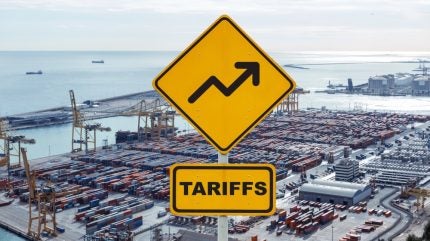
US ports are set to handle increased volumes of import cargo in July following a period of decline, but the rebound is expected to be temporary, according to the latest Global Port Tracker report released by the National Retail Federation (NRF) and Hackett Associates.
Short-term rise in container imports linked to tariff pause
The report forecasts that US container ports will process 1.86 million Twenty-Foot Equivalent Units (TEU) in July, a 5.5% rise from June.

Discover B2B Marketing That Performs
Combine business intelligence and editorial excellence to reach engaged professionals across 36 leading media platforms.
However, the increase is largely attributed to a temporary delay in new import tariffs scheduled to take effect later in the year. The surge is not seen as a sign of long-term growth but rather a front-loading response by importers seeking to avoid expected cost increases.
Looking ahead, August volumes are projected to reach 1.91 million TEU, down 3.4% from August 2023. September is forecast at 1.8 million TEU, a 4.4% year-on-year decline.
The NRF noted that uncertainty around trade policies is causing importers to adjust shipment timing, leading to volatility in monthly cargo volumes.
Year-to-date figures reflect mixed demand and policy pressures
Despite the July rebound, overall US import cargo levels for the first half of 2025 are slightly below last year’s figures.

US Tariffs are shifting - will you react or anticipate?
Don’t let policy changes catch you off guard. Stay proactive with real-time data and expert analysis.
By GlobalDataThe first six months of the year recorded 10.8 million TEU, down 0.4% from the same period in 2024. Full-year 2025 imports are forecast to reach 22.3 million TEU, a modest 1.2% increase from the 22.1 million TEU logged in 2024.
Hackett Associates founder Ben Hackett said in the report that the international shipping sector continues to face a mix of inflation-related cost pressures and unpredictable trade policy shifts, making accurate forecasting increasingly difficult.
He pointed to the tariff delay as a clear driver of short-term activity that is unlikely to continue into the autumn.
Retailers and ports prepare for fluctuating trade environment
Retail supply chains in the United States remain responsive to shifting import patterns. Ports including Los Angeles, Long Beach, and New York-New Jersey are preparing for uneven throughput in the coming months.
While the July uptick offers some temporary relief, port authorities are reportedly cautious, aware that incoming cargo levels could decline once tariffs are implemented.
The NRF emphasised that while retailers are committed to maintaining stable inventories, they remain concerned about how future tariff enforcement could affect supply chain costs and consumer pricing.
The Global Port Tracker report covers major US container ports and is based on data from the US Customs Bureau and port authorities.
It provides forward-looking insights that are used by retailers, shipping companies, and policymakers to monitor international trade activity and plan for logistics challenges.
Navigate the shifting tariff landscape with real-time data and market-leading analysis. Request a free demo for GlobalData’s Strategic Intelligence here.





